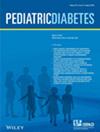混合闭环泵治疗青少年1型糖尿病的实际血糖改善
IF 5.6
3区 医学
Q2 ENDOCRINOLOGY & METABOLISM
引用次数: 0
摘要
目标。混合闭环胰岛素输送系统的使用,特别是具有控制智商(CIQ)的t:slim X2胰岛素泵,在临床试验和现实环境中已经证明了血糖控制的改善。我们试图描述使用CIQ在少数民族和非少数民族青年中血糖控制的变化。研究设计与方法。这是一项对青少年1型糖尿病(T1D)患者进行为期12个月的CIQ回顾性研究。医疗记录数据、泵数据和血红蛋白A1c (HbA1c)从开始CIQ前的就诊和开始CIQ后12个月的每次门诊就诊中收集。将连续血糖监测(CGM)数据和HbA1c随时间的轨迹与基线以及少数民族和非少数民族青年进行比较。结果。该研究包括136例患者,其中21例为少数族裔青年(非西班牙裔黑人和西班牙裔),50%为男性,中位年龄为13.3岁,中位糖尿病持续时间为4.9岁。开始CIQ后,非少数组的基线中位数HbA1c从7.8%降至7.1% (p <0.001),少数民族青年的基线HbA1c中位数从9.8%下降到7.8% (p = 0.03),达到HbA1c目标7%的患者比例从26%增加到45%。非少数民族和少数民族青年的平均CGM血糖在时间范围内显著增加,平均CGM血糖在时间范围内显著降低(p <0.05)。结论。在开始CIQ的12个月内,少数民族和非少数民族青年的HbA1c水平均有所下降,更多患者达到HbA1c低于7%的目标。少数民族和非少数民族青年之间的HbA1c差异仍然存在,需要进一步的研究来改善这一点。本文章由计算机程序翻译,如有差异,请以英文原文为准。
Real-World Glycemic Improvements with Hybrid Closed Loop Pumps in Youth with Type 1 Diabetes
Objective. The use of hybrid closed-loop insulin delivery systems, specifically the t:slim X2 insulin pump with Control IQ (CIQ), has demonstrated improvement in glycemic control in clinical trials and real-world settings. We sought to describe changes in glycemic control with use of CIQ in minority and nonminority youth. Research Design and Methods. This was a retrospective study of youth with type 1 diabetes (T1D) using CIQ over a 12-month period. Medical record data, pump data, and hemoglobin A1c (HbA1c) were collected from the visit prior to starting CIQ and at each clinic visit up to 12 months after starting CIQ. Continuous glucose monitor (CGM) data and HbA1c trajectory over time were compared to baseline and between minority and nonminority youth. Results. The study included 136 patients of whom 21 were minority youth (non-Hispanic Black and Hispanic), 50% were male, with median age of 13.3y, and median diabetes duration of 4.9y. After starting CIQ, baseline median HbA1c for the nonminority group decreased from 7.8% to 7.1% ( ), baseline median HbA1c for minority youth decreased from 9.8% to 7.8% ( ), and the percentage of patients meeting target HbA1c <7% increased from 26% to 45%. Both nonminority and minority youth had a significant increase in time in range and decrease of average CGM glucose ( ). Conclusions. HbA1c levels decreased in both minority and nonminority youth within 12 months of starting CIQ, and more patients reached the HbA1c target of less than 7%. Disparities in HbA1c between minority and nonminority youth remained and additional studies are warranted to improve this.
求助全文
通过发布文献求助,成功后即可免费获取论文全文。
去求助
来源期刊

Pediatric Diabetes
医学-内分泌学与代谢
CiteScore
6.60
自引率
14.70%
发文量
141
审稿时长
4-8 weeks
期刊介绍:
Pediatric Diabetes is a bi-monthly journal devoted to disseminating new knowledge relating to the epidemiology, etiology, pathogenesis, management, complications and prevention of diabetes in childhood and adolescence. The aim of the journal is to become the leading vehicle for international dissemination of research and practice relating to diabetes in youth. Papers are considered for publication based on the rigor of scientific approach, novelty, and importance for understanding mechanisms involved in the epidemiology and etiology of this disease, especially its molecular, biochemical and physiological aspects. Work relating to the clinical presentation, course, management and outcome of diabetes, including its physical and emotional sequelae, is considered. In vitro studies using animal or human tissues, whole animal and clinical studies in humans are also considered. The journal reviews full-length papers, preliminary communications with important new information, clinical reports, and reviews of major topics. Invited editorials, commentaries, and perspectives are a regular feature. The editors, based in the USA, Europe, and Australasia, maintain regular communications to assure rapid turnaround time of submitted manuscripts.
 求助内容:
求助内容: 应助结果提醒方式:
应助结果提醒方式:


